
- Home
- India
- World
- Premium
- THE FEDERAL SPECIAL
- Analysis
- States
- Perspective
- Videos
- Sports
- Education
- Entertainment
- Elections
- Features
- Health
- Business
- Series
- In memoriam: Sheikh Mujibur Rahman
- Bishnoi's Men
- NEET TANGLE
- Economy Series
- Earth Day
- Kashmir’s Frozen Turbulence
- India@75
- The legend of Ramjanmabhoomi
- Liberalisation@30
- How to tame a dragon
- Celebrating biodiversity
- Farm Matters
- 50 days of solitude
- Bringing Migrants Home
- Budget 2020
- Jharkhand Votes
- The Federal Investigates
- The Federal Impact
- Vanishing Sand
- Gandhi @ 150
- Andhra Today
- Field report
- Operation Gulmarg
- Pandemic @1 Mn in India
- The Federal Year-End
- The Zero Year
- Science
- Brand studio
- Newsletter
- Elections 2024
- Events
Why Kerala’s mahouts are unable to ride past their jumbo troubles

This reporter met him in a dimly lit, crowded bar on the border between Thrissur and Palakkad districts. The air was thick with the smell of cheap liquor and the aroma of ‘touchings’ — small bites like pickles and fries. The setting was far from ideal for an interview, but he insisted on meeting here, with strict conditions: complete anonymity for himself and his elephant, whom he...
This reporter met him in a dimly lit, crowded bar on the border between Thrissur and Palakkad districts. The air was thick with the smell of cheap liquor and the aroma of ‘touchings’ — small bites like pickles and fries. The setting was far from ideal for an interview, but he insisted on meeting here, with strict conditions: complete anonymity for himself and his elephant, whom he had entrusted to his deputy—the second mahout—and chained at a nearby temple ground. Initially, I couldn’t even disclose the elephant’s gender, as it might reveal too much. Later, however, he allowed me to share this detail, while I refer to him in this narrative as "Murukan"—an attributed name to protect his true identity.
After a couple of stiff drinks and a special BDF (beef dry fry)—just part of his routine—he began to open up.
Murukan was just 14 when his elder sister eloped with a mahout, defying their caste hierarchy, and was subsequently expelled from the family. It was his passion for elephants that had drawn her to the temple festivals, where she eventually fell for the mahout.
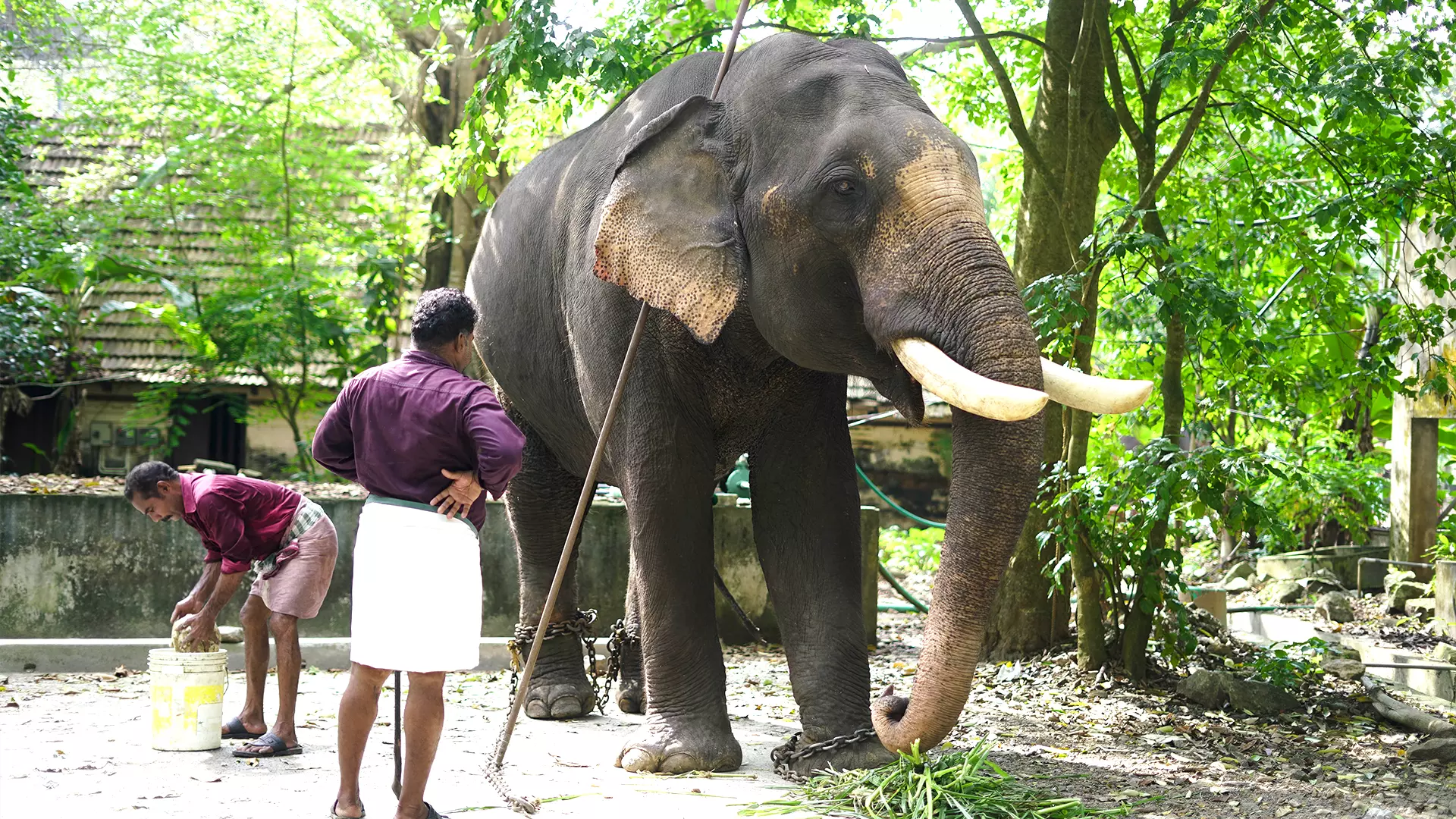
A still from Punnathoor Kotta elephant facility.
After she left, Murukan ran away to Tamil Nadu, enduring two years of hardship—doing all kinds of child labour, from washing dishes at restaurants to selling tea at bus stands. When he returned home, he was not welcome, but his sister took him in. It was her husband, a deputy to a famous mahout, who introduced him to the craft of mahout-ship. Murukan was only 16 then, and his job was to climb palm trees to cut leaves for the elephant—a task every trainee mahout begins with.
He has been in the trade for the last three decades. Now, at 46, he looks after an elephant with the help of two deputies, but he has no family of his own, a consequence of his habitual alcoholism and the troubles it brought.
“I have no formal education beyond class seven, and when it comes to looking after elephants, I learned it from other mahouts. But even that wasn’t through any formal teaching. No one treats you well in this trade. It’s a hard life. You could be exploited in every way—physically, even sexually. If you’re not placed in a well-maintained Devaswom, a wealthy temple trust, or perhaps in timber business, a mahout’s life is terrible. In my case, I have my own demons. I blame my drinking habit and bad company for my downfall. But with only my sister as a relative, I feel like an elephant myself—sky above and earth beneath,” he says in a self-lamenting and slightly philosophical mood.
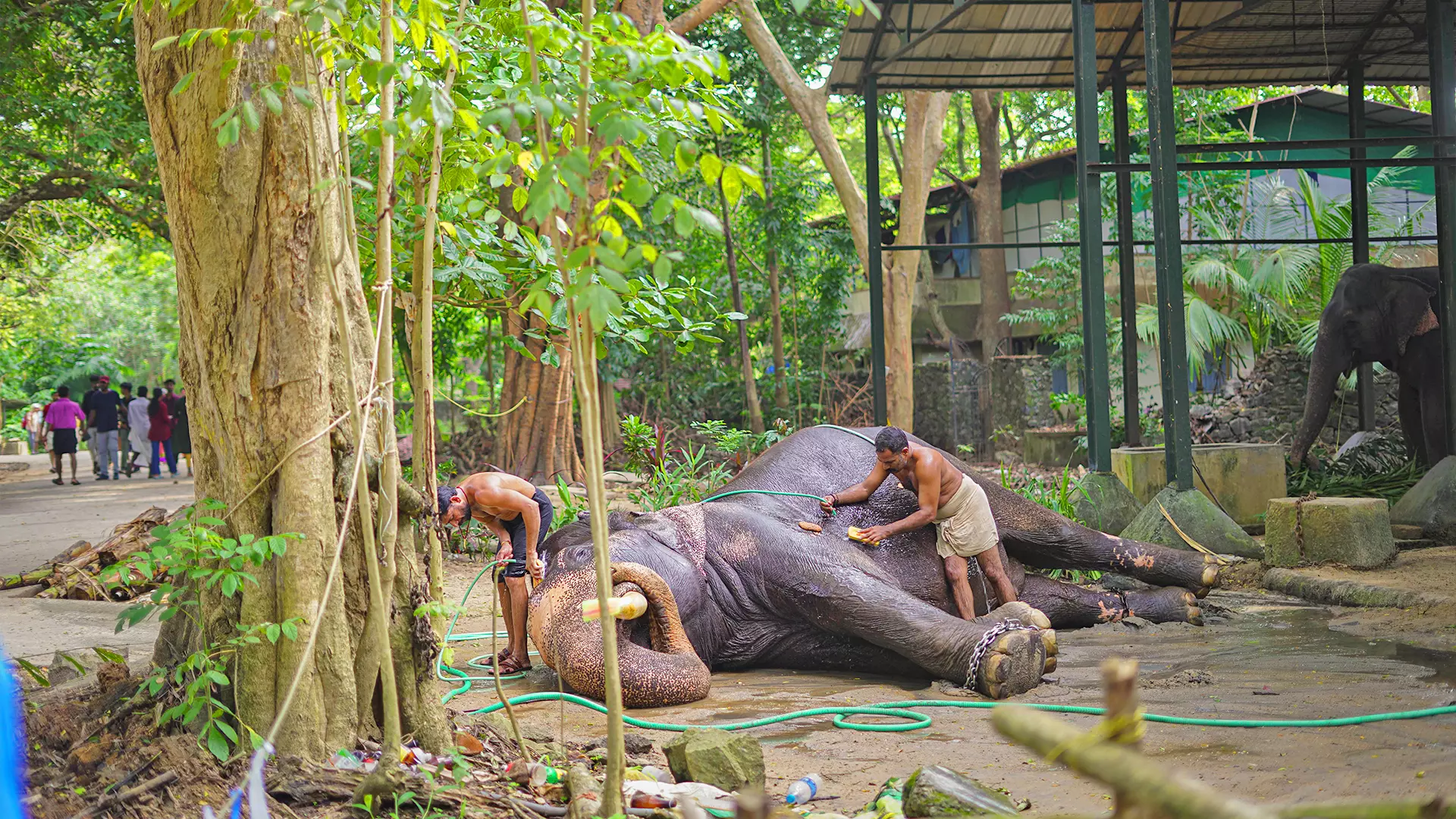
An elephant receives a cool spa.
Murukan’s story reflects the lives of hundreds of mahouts across Kerala, who have minimal job security and live in constant fear for their safety. Yet, there is also a group among them who is genuinely passionate about caring for elephants, despite the hardships.
According to some studies, the plight of mahouts is deeply concerning, as is the lack of adequate protective laws and training for them. Mental health and physical fitness are essential for mahouts to effectively and safely manage elephants. Proper training for them is also a vital factor. Many mishaps could be avoided if mahouts received proper training and elephants were not subjected to excessive workloads. Public safety and property could be better protected through the introduction of appropriate regulations.
“We’ve conducted knowledge assessment tests two or three times, and the deterioration in quality is a real issue. They’re not receiving proper training, and there’s no documentation or record of experienced mahouts’ insights that could serve as training material for the next generation. Because of the lack of job security, fewer people are entering the field, so the generational transfer of skilled mahouts isn’t happening. Many become seasonal mahouts, taking up other jobs in the off-season, and we can’t blame them. This decline in quality has led to a lack of training, creating a cycle that keeps repeating,” shares Marshal C Radhakrishnan, a researcher who has done extensive work on the subject.
According to studies conducted by researchers including Marshal C Radhakrishnan, this working class faces numerous psycho-social challenges, including isolation, lack of a regular social life, and the constant danger associated with their profession. Even a minor injury or attack by an elephant can often be fatal, yet mahouts are frequently blamed for such incidents, without adequate consideration of their harsh working conditions, job risks, and socio-economic hardships.
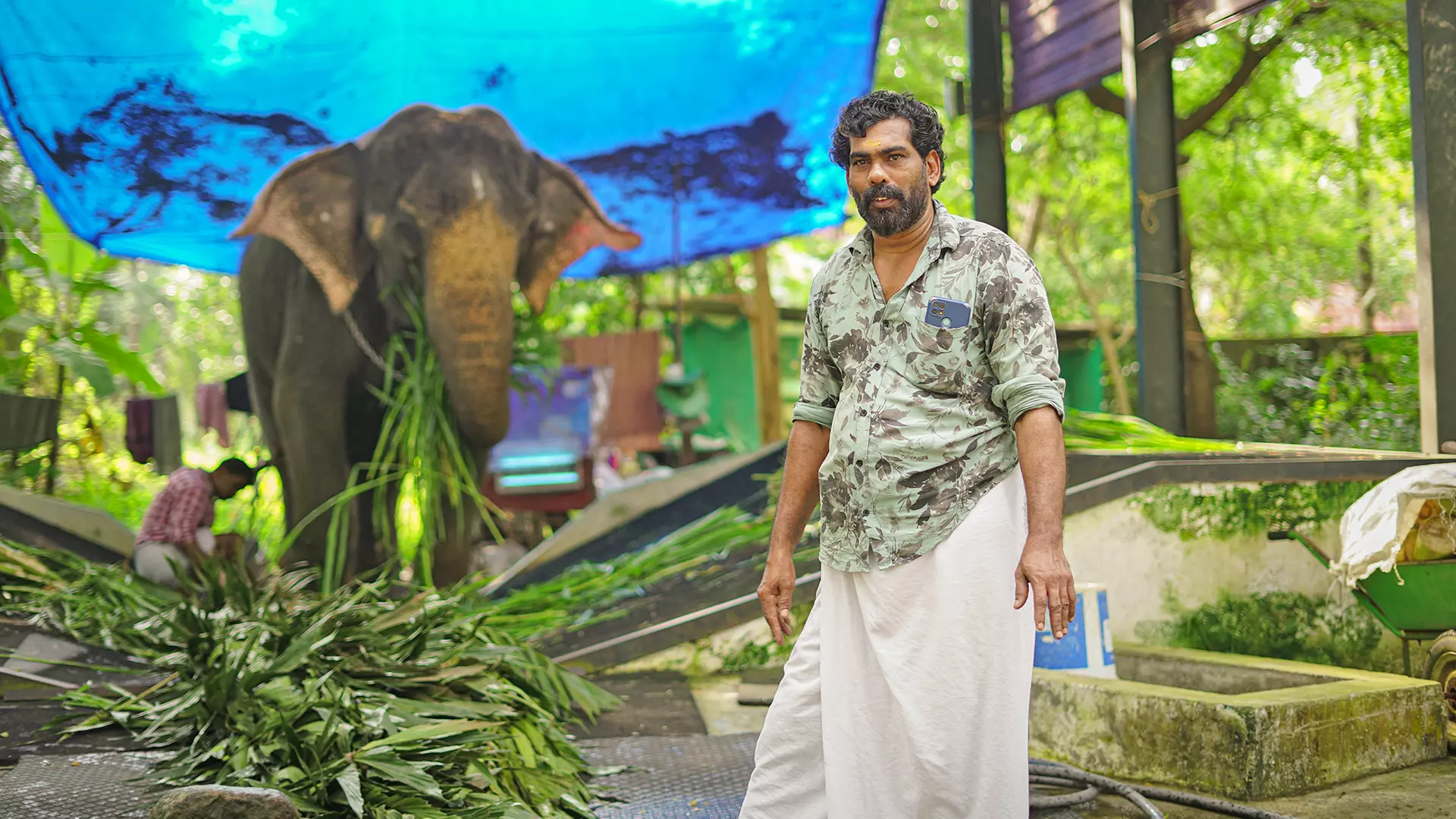
Nandini, the oldest elephant of the Punnathoor Kotta camp, with her mahout.
In addition to the physical dangers, mahouts struggle with personal issues, such as family life, child care, and the education of their children, which are often neglected in discussions about their profession. This lack of attention to their overall well-being highlights the need for greater recognition and support for mahouts, whose lives and contributions remain largely overlooked.
The Guruvayoor Temple Devaswom Board in Kerala currently houses 39 elephants at the Punnathoor Kotta elephant facility. This historical site, once a fort and palace, is located about 3 km from the Guruvayoor Sree Krishna Temple in Kottapadi. At one point, there were as many as 84 elephants, but the number has gradually declined, with the most recent loss being that of elephant Kannan earlier this year. Nearly 100 mahouts and assistants are employed at the facility. The pay for an entry-level mahout in Guruvayoor Devaswom is Rs 24,400– Rs 55,200, resulting in a gross monthly salary of Rs 46,669, which includes benefits such as insurance, a pension scheme, and designated staff quarters. This is Kerala’s most well provided elephants and mahouts facility.
The basic qualifications for recruiting mahouts are the ability to read and write Malayalam and two years of experience as a mahout or in elephant training. This low qualification requirement highlights two issues: a scarcity of skilled hands and a lack of formal training facilities in the state.
When The Federal visited the facility, it was a day for feeding the elephants, a ritual often offered by devotees as an act of devotion. All the elephants—except those in musth (a condition of heightened aggression and unpredictable behaviour occurring annually in certain elephants), who were kept chained with food served at their respective places—were gathered in the open space within the fort and fed a traditional offering of rice, jaggery, plantains, coconuts, and other treats as part of the feeding of the Lord's elephants.
Ganesh Kumar, a 45-year-old mahout who looks after the elephant Guruvayoor Sidharthan, has a story similar to Murukan’s, though without the dramatic coming-of-age. Unlike Murukan, Ganesh has a stable income, a steady job, and a family.
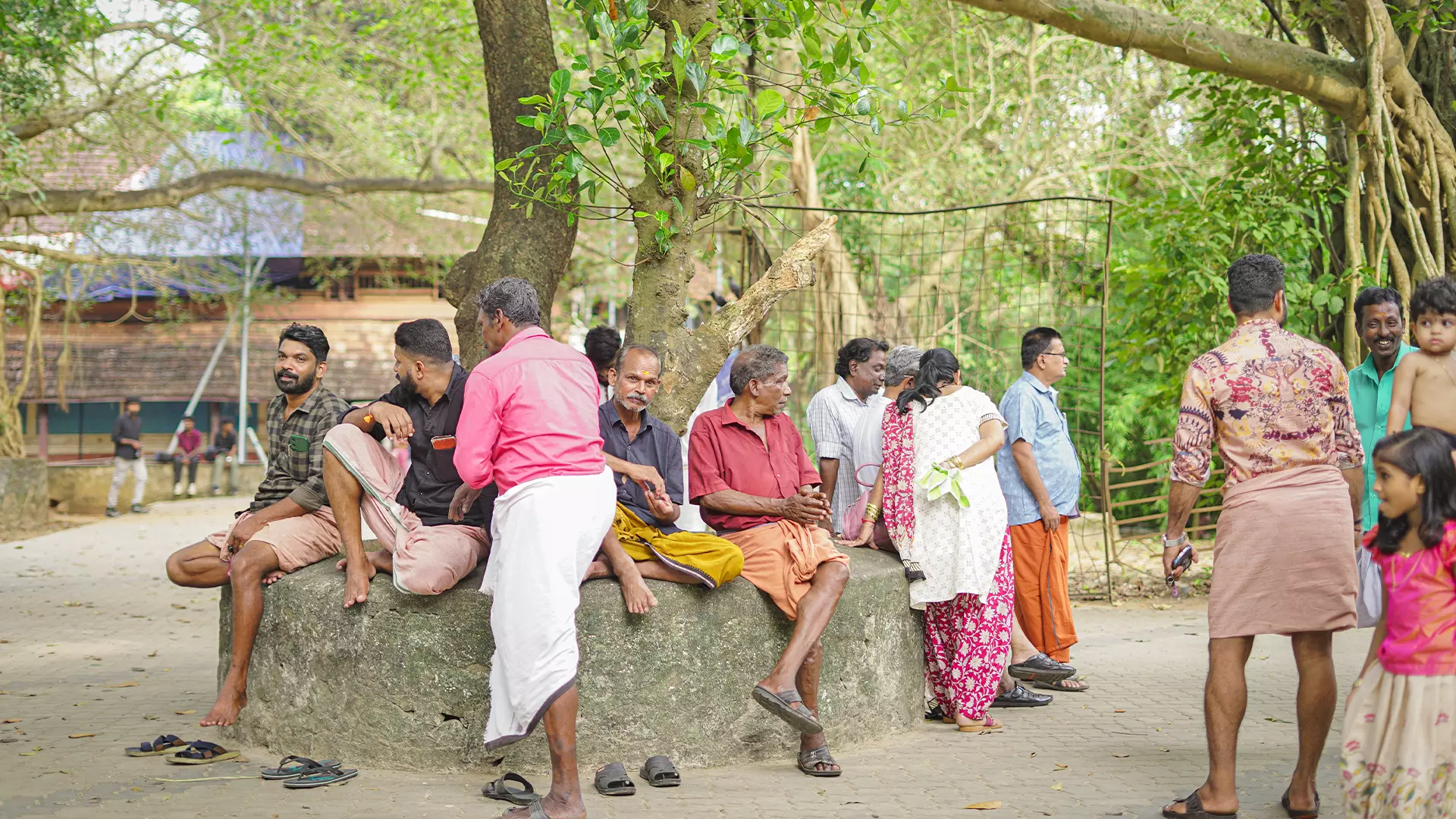
Mahouts having some leisure time at Punnathoor Kotta.
“I started the job by assisting the senior mahouts from our native place, Kulappully, in Palakkad district. I was 15 when I started, and I dropped out of school after grade seven. There were many great mahouts back then, and some of them took me under their wings and recommended me for a private job. Later, I got this opportunity. For me, I definitely have a love for elephants, but now it’s my job to look after these giant animals,” Ganesh told The Federal, while his assistant fed Sidharthan from a distance, as the elephant was in musth and chained. Elephants in musth can be dangerous, so mahouts maintain a safe distance while feeding them. All the other elephants were fed directly at their mouths.
“Obviously, the job comes with risks since we’re dealing with an animal. That’s part and parcel of it,” says Ganesh. “At times, we have to use a bit of tough love, but that too is essential. Don’t we punish our own children when they misbehave?”
Profession born out of elephants love
While Ganesh views mahout-ship as a profession, there are others for whom their passion for the animal takes the front seat. Krishnamoorthy, also known as Singan, is the mahout of Indrasen, the leader of the pack of Guruvayoor elephants. Indrasen is the tallest and finest elephant available now, commanding a daily fee of Rs 2.72 lakh this year—a record for any elephant. Indrasen, believed to have been born in 1972, was donated to the temple in 1979 by a North Indian businessman, Indersen Mirchandani, and was named after him.
“I came to this trade out of passion. To be with an elephant and to sit on him was a real motivator. Now, he is a family member to me—just like my wife, parents, or children… at times, even more than them. It’s basically a trust between us and the animal. He obeys me. So far, there have been no untoward incidents with him, but the risk is always there, especially during festivals, when other elephants and large crowds are involved. We are all tense until the rituals are over and he’s safely embarked in the vehicle,” says Krishnamoorthy, aka Singan.
The risks are big enough to keep many people away.
The librarian of the municipal library, Guruvayoor, K V Janardhanan, is someone who chose not to follow the path of a mahout. His father was a mahout with the Guruvayoor Devaswom, and his sister’s husband is one as well. However, Janardhanan never felt drawn to the trade, fully aware of the risks involved, and his father was never in favour of his children joining him in the field.
“There’s a saying in Malayalam: Aanachoru, Kolachoru ‘Elephant work earns nothing but death’s bread’, and it’s true in my experience. I still remember the tense days when my father would go out with the elephant for festivals. Even now, my brother-in-law continues this work, and it’s always risky. I recall incidents of mahouts being gored and trampled by elephants. One of our closest family friends, Gopalakrishnan, was tragically trampled by the elephant Keerthi in 2007. It was a horrific death; reports even suggested the elephant bit him and tried to consume his body. Despite it being a quasi-government job with pension and benefits, my dad didn’t want me to follow in his footsteps,” Janardhanan told The Federal.
A diminished status
In the past, mahouts were revered and held in high esteem, but today their status has diminished significantly. Despite the presence of various organisations dedicated to elephant welfare, there is little support for the mahouts themselves, who spend their lives caring for these majestic creatures.
In Malayalam literature and cinema, mahouts have often been portrayed in complex roles that reflect both their deep connection with elephants and the dangers inherent in their profession. These characters are sometimes depicted as heroic figures, embodying toughness, resilience, and a deep sense of duty towards the animals they care for. At other times, they are portrayed as seductive figures, with the elephant symbolising various concepts, particularly sexual power and dominance.
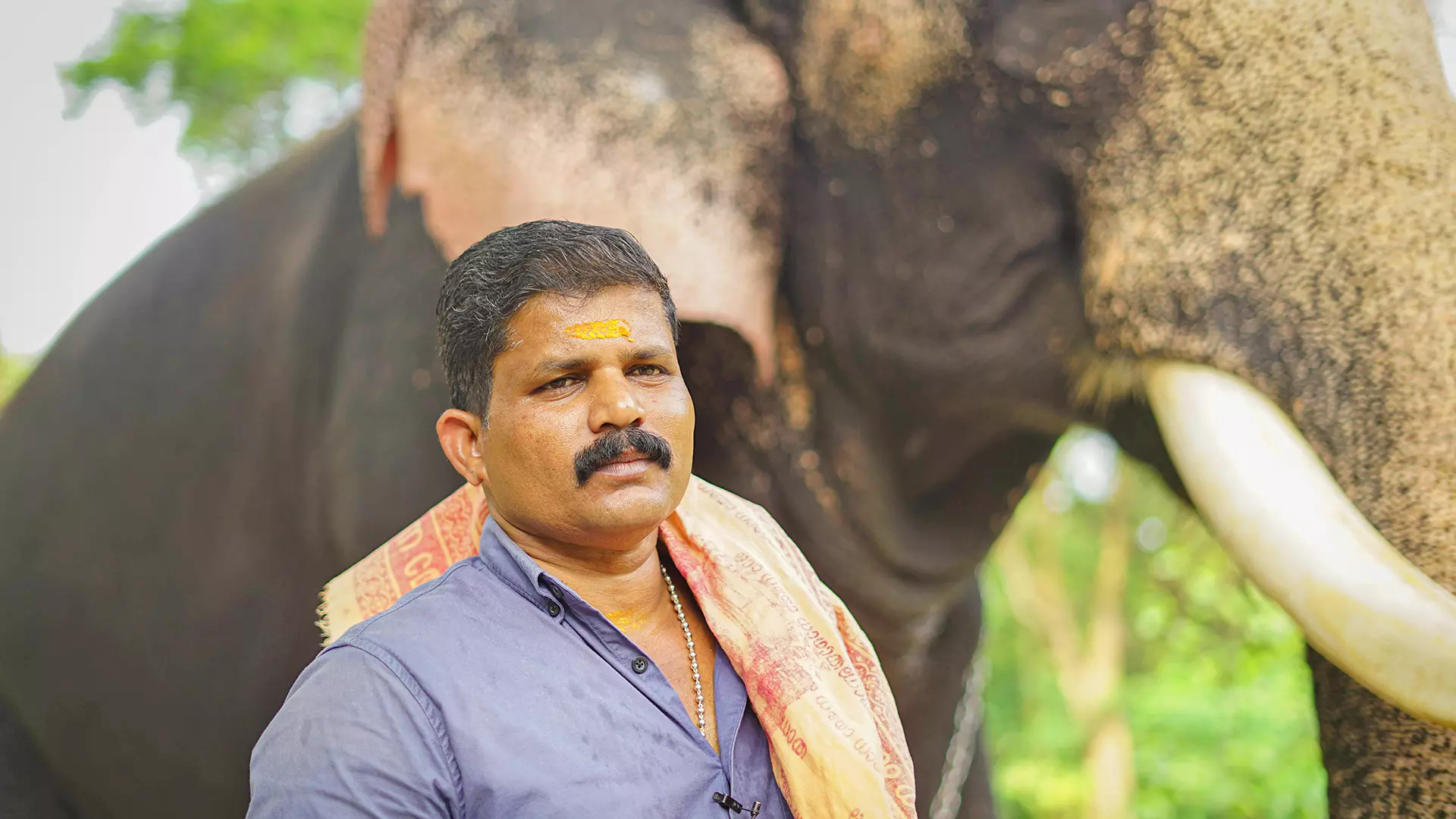
Krishnamoorthy aka Singan with Indrasen.
In recent years, mahouts, particularly younger ones, have gained significant attention on social media, where they showcase their elephants and demonstrate their skills in taming these powerful animals. These young mahouts have amassed thousands of followers, using platforms like Instagram and YouTube to share videos of their interactions with elephants and their unique techniques in the field. Social media has granted them a new kind of recognition, with respect both in the digital realm and public life.
However, while these young mahouts are celebrated online, many have yet to master the traditional craft of elephant care, which demands years of experience, dedication, and hands-on learning. The profession, deeply rooted in generational knowledge, requires a nuanced understanding of the elephants’ behaviour and physical needs, something that cannot be entirely learned through social media alone.
While social media has brought some of these young mahouts into the limelight, the reality for the majority of mahouts remains starkly different. Many still face a lack of job security, compounded by limited awareness of their rights and the welfare schemes available to them. This lack of support structures means that even as the profession grows in visibility online, the basic challenges of the job—such as poor working conditions, inadequate training, and the risks of injury—continue to affect their lives significantly.
“When I started researching their lives, most of the mahouts wouldn't even speak out. Hardly anyone knew about the insurance schemes available to them. Now, the situation has changed, with fan pages emerging for mahouts just like for elephants. However, this growing visibility has also brought challenges to their jobs,” says Marshal C Radhakrishnan.
“I was part of the committee that designed a curriculum for mahouts, initially intended as a three-year programme, but it was never fully implemented. Today, there are training camps conducted by the forest department, but no one can truly become a professional through a short-term camp lasting just five days or so. Experienced mahouts often say that elephants teach them new lessons every day. These are unpredictable animals, and we still don’t fully understand their behavioural patterns. As an expert who conducts classes for them, I focus on relieving job stress and providing psychosocial awareness. Classroom-style training isn't always effective, especially since most mahouts are school dropouts and not academically inclined. Instead, I use videos documenting the lives of mahouts to raise awareness,” adds Marshal.
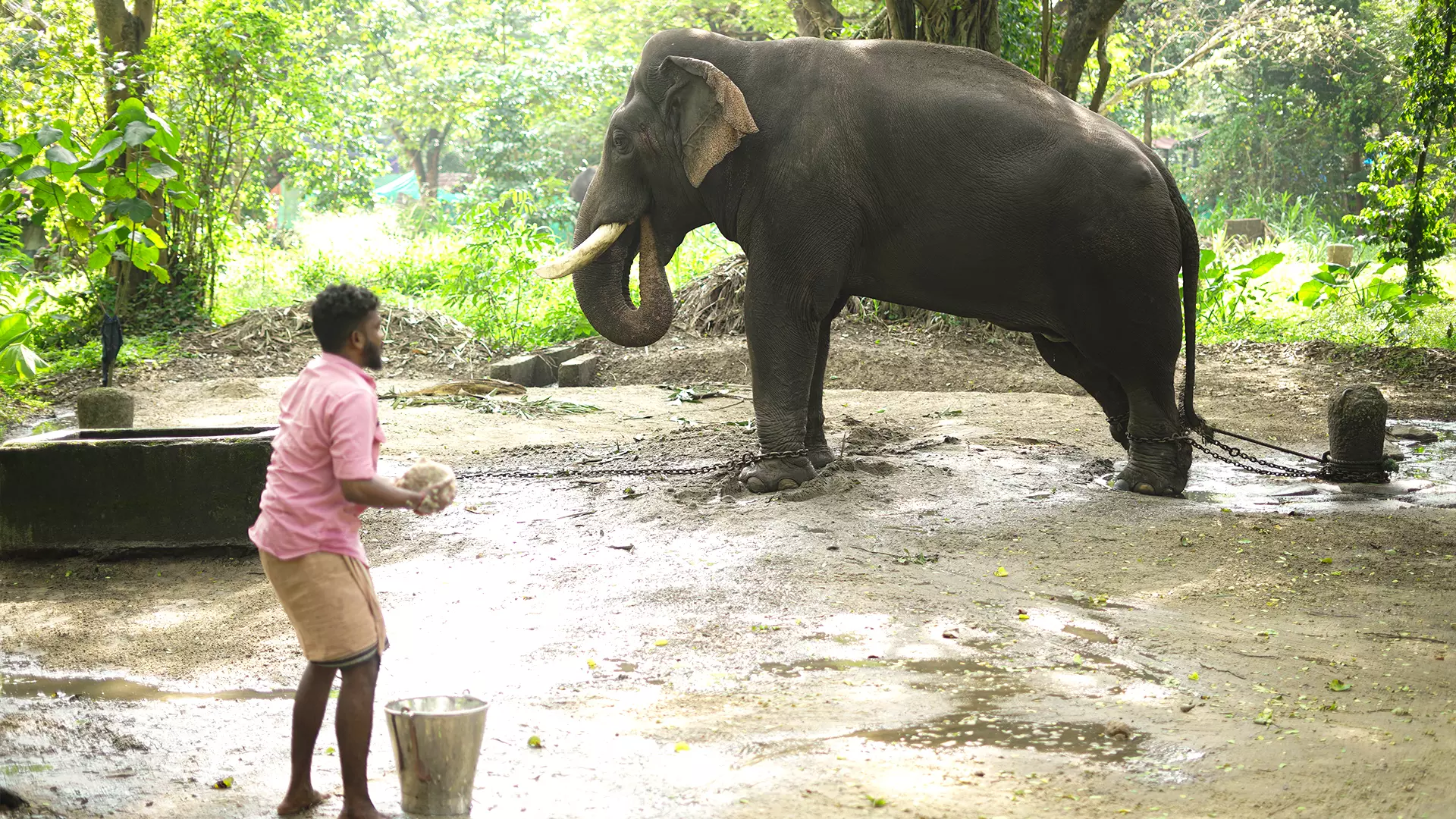
Feeding an elephant in musth. It is highly to dangerous to go near the jumbos during this phase.
Researchers suggest that the man-elephant conflict cannot be resolved solely through scientific training of mahouts. In addition to proper training, mahouts must be provided with safety measures, risk coverage, and support from both the public and the government. Effective management of elephant-related incidents also requires detailed investigations into various factors, including the elephant’s ownership history, its behavioural patterns, and the management practices in place.
Crucially, it’s essential to examine the relationship between the mahout and the elephant, focusing not just on punishment but on the techniques used by the handler to maintain control.
